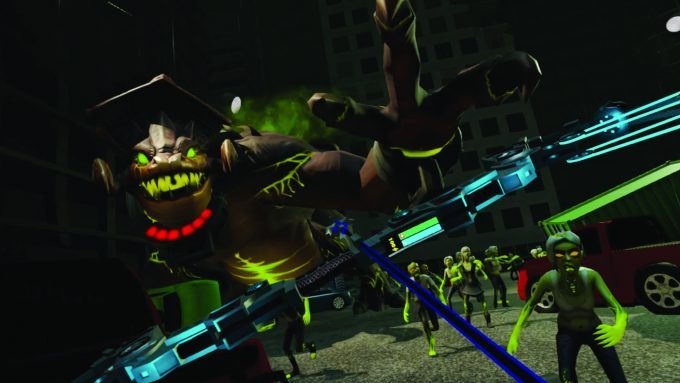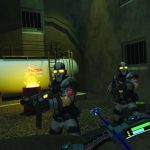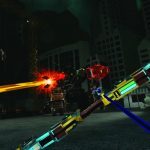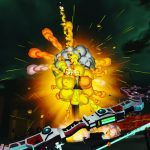Whereas traditional FPS titles have settled on the gun as a primary weapon, it seems the bow & arrow is increasingly becoming a favorite of the VR FPS. Twisted Arrow, the next title from Phaser Lock (the studio behind the well received Final Approach) lets the player wield a superpowered bow for high-action gameplay.
Compared to Final Approach (2016), an arcade puzzle game about guiding planes safely onto runways, Twisted Arrow is a huge step in the action direction for studio Phaser Lock. At the center of Twisted Arrow is a high-tech bow that makes the player a deadly opponent for the hordes of enemies they will face.
 Hordes indeed, but Phaser Lock CEO Michael Daubert says the game is absolutely not a ‘VR wave-shooter’, a genre which is on its way to becoming overrun with bland experiences. Instead, players will work their way through six hand-crafted levels, four of which will culminate in boss fights, for some four to six hours of gameplay. Enemies will vary from para-military combatants to robots, zombies, drones, and more.
Hordes indeed, but Phaser Lock CEO Michael Daubert says the game is absolutely not a ‘VR wave-shooter’, a genre which is on its way to becoming overrun with bland experiences. Instead, players will work their way through six hand-crafted levels, four of which will culminate in boss fights, for some four to six hours of gameplay. Enemies will vary from para-military combatants to robots, zombies, drones, and more.
Daubert told me that many of the game’s design decisions were about keeping things fast paced. The high-tech bow that the player will wield is at the core of that pace. Instead of slowly unlocking new abilities over time, the player gets access to everything up front. That includes multiple special arrows (like freeze and explosive), and the ability to temporarily transform your bow into a force shield.
 Players will navigate around each mission through a node-based teleportation system. Daubert says that when they tested the game with an open-ended teleport system, players spent too much time trying to position themselves for cover using artificial locomotion. Changing to a node-based system encourages the player to physically move about their playspace to dodge and use the virtual cover that’s available at the nodes. Asking players to actually dodge bullets and duck behind cover increased the physicality of the game too, something that the studio wanted to be part of the experience (without it being too physical that players get tired quickly).
Players will navigate around each mission through a node-based teleportation system. Daubert says that when they tested the game with an open-ended teleport system, players spent too much time trying to position themselves for cover using artificial locomotion. Changing to a node-based system encourages the player to physically move about their playspace to dodge and use the virtual cover that’s available at the nodes. Asking players to actually dodge bullets and duck behind cover increased the physicality of the game too, something that the studio wanted to be part of the experience (without it being too physical that players get tired quickly).
Daubert says the studio has carefully tuned the bow mechanics to maintain a sense of high-speed combat. Instead of drawing the arrow from a quiver on your back (as some VR bow & arrow games do), simply grabbing the bow string will nock an arrow and leave you ready to fire. They’ve also designed the bow and its drawing mechanics to favor a somewhat tilted orientation, so that players avoid hitting their VR headset with their controllers when pulling the string back (as with a real bow you would pull your hand right up to your check to aim down the arrow).
At one point during development, the studio had an Olympic archer visiting to give the game a try just for fun; Daubert says he was far and away the highest scoring player to try the game so far, with something like 98% accuracy.
Twisted Arrow will launch on both HTC Vive and Oculus Rift, with a tentative release date set for mid-March. Following the launch, the game will get updated to support competitive and cooperative multiplayer that’s cross-platform, along with leaderboards. The game will launch priced at $25 with a 25% launch discount.










